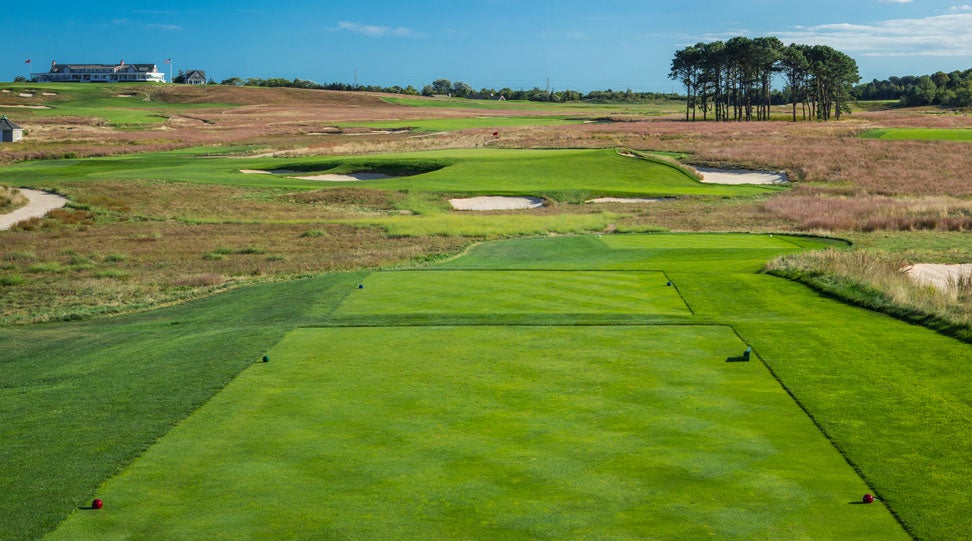 This driving range isn’t fancy. But the game could learn something from it
This driving range isn’t fancy. But the game could learn something from it
What is an Alps hole, and why do people think it’s so great?

Welcome to A Beginner’s Guide to Golf Course Design, where we’ll dig into the history, design and meaning of golf course architecture terms you’ve probably heard before but might not fully understand. We’ll explain all of the above in an accessible Q&A format, and better yet, teach you how to identify these features and plan your attack for the next time you see one, saving you strokes along the way. In this installment, we’re breaking down Alps holes.
What is an Alps template hole?
One of the more interesting par-4 templates, the Alps hole can be one of most fun challenges on the course. The template is called an Alps because a large hill or mountain blocks the player’s approach and view of the green on his or her second shot. Because of the blind nature of the second shot, many courses give the pin location on the tee, or have something large behind the middle of the green like a flagpole, helping players aim to an approximate area.
While there is no specific fairway direction or bunkering on an alps hole, there is a lot of similarity in the greens and surrounding area. Many of the best Alps holes have punchbowl greens because of the blind nature of the shot, making it less penal. The green often sits in the hollow of the mountain (like the original) and has a bit of a bank behind to help with long shots. There is almost always a large and deep bunker along the entire front of the green which is also blind to the approach shot. This type of bunkering, even when it appears on other holes, is often referred to as “Alps bunkering.”
Because golf architecture looked down on blind shots for many years after the golden age, there are not many Alps holes in existence. But when you come across one, it can be one of the most exhilarating approach shots of your life.
Is it from Switzerland?
Like most of the other template holes, C.B. Macdonald brought this one back to the U.S., but he didn’t it in the Swiss Alps. He based it on the 17th hole at Prestwick Golf Club in Scotland. The green is sunken into the side of a hill and is fronted by a massive trench bunker. The front bunker is a treacherous grass faced bunker known as the Sahara, just a mess of a spot to be in. The green is slightly punchbowl in style to help funnel in solid shots. The hole has undergone almost no change over the years, playing as wonderfully as it always has.
Why did Macdonald like it so much?
In an article discussing the alps hole at National Golf Links of America, C.B. Macdonald, along with H.J. Whigham, said, “All the leading golfers of Great Britain were asked to name the best holes in the world. They were almost unanimous in choosing the Alps at Prestwick as the best two-shot hole.” It’s easy to see why; the design is full of intrigue and excitement for a player of any skill level. Blind shots are so damn fun because you have to wait so long, especially when walking, to see if your shot was any good. Macdonald and Whigham wrote, “The player is frequently pleasantly or unpleasantly disappointed when he comes to the top of the hill and surveys the result beneath him.”
I don’t want a blind shot!
Holes with blind shots were not popular in golf design for a long time and it’s easy to understand why. They seem to be “unfair.” How should I know where to hit it if I can’t see it? But guess what, just like life, golf isn’t fair! Part of having a good round of golf is dealing with the unlucky breaks and keeping your cool.
There are some Alps holes where the angle into the green can give you a view, but many are blind no matter what. Here’s my advice: Enjoy the excitement! We almost always know immediately where our ball lands and what the outcome is. Climb the hill up to the green with the ignorance of your location. It’s the Schrodinger’s Cat of golf shots. Until you reach the green, you could be in the bunker, or you could be in the hole!
ADVERTISEMENT
Where are some other Alps holes?
Fishers Island (No. 4)
Playing along the water, many consider the Fishers Island Alps hole to be the best in the world. The hole plays over a chasm from the tee, and the punchbowl green is very pronounced with tight grass around all the edges. The green is blind from most of the fairway, but the beautiful views are always visible.
National Golf Links of America (No. 3)
The first Alps Macdonald built, this one features a diagonal left-to-right fairway, adding interest from the tee. Of the hole, Tom Doak said, “Macdonald’s third hole at National Golf Links was not just an homage to the Alps at Prestwick, but an improvement on the hole.” It takes a true golf genius to improve on anything from Prestwick.
Lookout Mountain Club (No. 11)
Lookout Mountain Golf Club has another fabulous Alps hole built by Macdonald’s protégé Seth Raynor. Because of the blind nature of the approach shot, there is a large flagpole behind the center of the green. The green has deep bunkers on either side rather than the front. This one is extra interesting because it plays downhill to the green.
The Greenbrier (Old White, No. 13)
Not a strict Alps because you can get a view of the green from one side of the fairway, the 13th at TPC’s Old White is still a wonderful hole. The front hill is severe and still makes for a challenging test. A river runs down the left side of fairway, and the closer you keep your ball to the water, the better the view of the green. Success on this hole takes strategy from the tee box all the way to the green.
St. Louis CC (No. 18)
The Alps hole at St. Louis Country Club is an incredible way to finish a round of golf. The uphill tee shot bends to the left with the clubhouse behind. The blind green is fronted with a deep bunker with very little area to get a good stance or lie. There aren’t too many mountains in Missouri, but Macdonald found a way to make an Alps template anyway.
Want more golf course architecture content?
What is a ‘short’ hole?
5 hole design templates that will never go out of style
What are template holes?
To receive GOLF’s all-new newsletters, subscribe for free here.
ADVERTISEMENT






